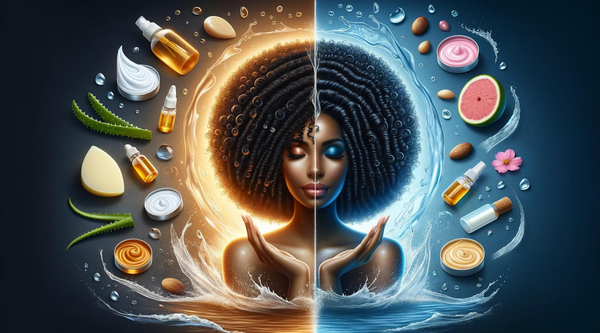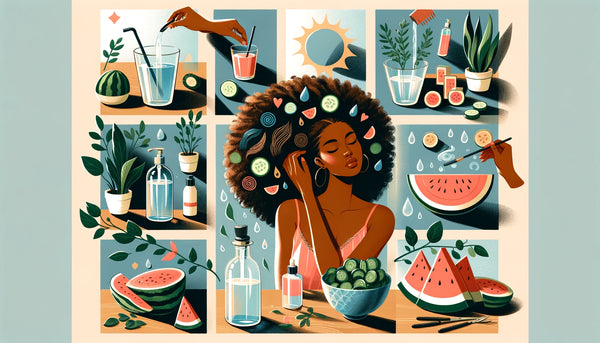Are You Hydrating Your Natural Hair Wrong? Here’s How to Tell
Hey, beautiful!
Navigating the world of hair care can feel like solving a complex puzzle, especially when dealing with the unique structure and needs of African American hair. Ever noticed how your hair seems to resist certain styles, or feels dryer than the Sahara? Well, it's not just you – it's a hydration thing.
Understanding Hydration vs. Moisturization for Kinks and Curls:

First off, let’s get our terms right. Hydrating your hair is different from moisturizing it. Imagine hydration as quenching your hair's thirst from within, while moisturization seals and protects that moisture.
Hydration: This is all about water. Hydrating your hair means increasing the water content within your hair strands. For folks with kinks and curls, this is especially crucial. Curly hair has a natural propensity to be less hydrated than straight hair due to its shape; the oils from the scalp have a harder time traveling down the length of the hair. Therefore, adding water back into your hair is essential. This can be achieved through using water-based products or by implementing regular water rinses into your hair care routine. Hydration is the foundation of healthy hair – think of it as the drink your hair needs when it's thirsty.
Moisturization: Now, once your hair is properly hydrated, it’s time to make sure that hydration doesn't just evaporate away. That's where moisturization steps in. Moisturizing hair involves using oils, butters, and other substances to create a seal over your hair strand. This seal helps to lock in the water you've added during the hydration step. Without proper moisturization, all that lovely hydration could escape, leaving your hair drier than a desert. Especially in African American hair, which may be more prone to dryness, sealing in moisture is a critical step in maintaining hair health and preventing breakage.
The balance between hydration and moisturization is a delicate dance. Too much moisture without enough hydration can lead to product build-up and lackluster, heavy curls. On the other hand, too much hydration without sealing it in can lead to chronic dryness and breakage.
To maintain this balance, consider incorporating hydrating and moisturizing routines into your hair care regimen. Start with hydrating treatments – or simple water spritzing – followed by natural oils or butters to seal in that moisture.
And here’s where we introduce a game-changer – our Spray & Go Conditioning Mist. Specially crafted for the unique needs of African American hair, this mist is a hydration powerhouse, packed with natural ingredients like Aloe Vera and Rosewater to soothe, hydrate, and rejuvenate your beautiful locks.
The Role of Water in Maintaining Healthy Black Hair:
Water is the lifeline for all types of hair, but it plays an especially pivotal role in the health and maintenance of African American hair. Here’s why:
African American hair is like a sponge – it's hydrophilic, meaning it loves water and is naturally inclined to absorb moisture from the air. This characteristic is a double-edged sword; while it can easily absorb water, it can also lose moisture just as quickly, especially in dry environments.
Common Signs of Hair Dehydration:
Understanding the cries for help from your hair is pivotal in maintaining its health and vitality. Here are some key indicators that your hair might be more parched than a cactus in the desert:
- Increased Breakage: When your hair is dehydrated, it becomes more fragile and prone to breakage. If you notice more hair than usual snapping off during combing or styling, it's a significant sign that your hair is lacking in moisture. This is because hydrated hair is more elastic and can withstand tension better than dry hair.
- Rough Texture: Run your fingers through your hair. Does it feel rough or straw-like? When hair loses its moisture, it can feel coarse to the touch. This is due to the cuticle (the outer layer of the hair) being raised and damaged, making your hair feel rough and tough.
- Dull Appearance: Hydrated hair has a natural sheen and luster because the cuticle lies flat and reflects light. Conversely, dehydrated hair often looks dull and lackluster because the raised cuticles scatter light instead of reflecting it.
- Itchy, Flaky Scalp: While it's a common misconception that dandruff is solely a result of dry skin, a dry and itchy scalp can indeed be a sign of hair dehydration. When your scalp lacks moisture, it can become irritated and flaky. This is your scalp’s way of sending an SOS signal for more hydration.
- Tangles and Knots: Dehydrated hair can become tangled and knotty more easily than well-moisturized hair. This is because the rough and damaged cuticles catch on each other, leading to frustrating tangles and knots.
- Lack of Elasticity: Hydrated hair is like a good quality elastic band; it can stretch and return to its original shape without breaking. To test your hair’s elasticity (and thus its hydration levels), gently stretch a small section of your hair. If it breaks easily without much stretch, it’s likely dehydrated.
Daily Habits for Enhanced Hair Hydration:

Hydration starts within and extends beyond just hair care products. Here are some daily habits that can make a monumental difference in the hydration and overall health of your hair:
- Internal Hydration: The foundation of hydrated hair is a well-hydrated body. Drinking plenty of water is not just beneficial for your skin and overall health; it's crucial for maintaining moisture in your hair as well. Aim for at least eight glasses of water a day to ensure that your body and by extension, your hair, are adequately hydrated.
- Choose the Right Products: Utilize hair care products specifically designed for your hair type, as these are formulated to address its unique needs. Look for products rich in hydrating ingredients like aloe vera, coconut water, honey, and glycerin.
- Protective Styling: Protective styles such as braids, twists, and updos can help retain moisture by reducing exposure to environmental stressors and decreasing the frequency of hair manipulation. Remember to keep your scalp clean and moisturized even when wearing protective styles.
- Seal in Moisture: After moisturizing your hair with water or a water-based product, seal in that moisture with a natural oil or butter, like shea butter, jojoba oil, or coconut oil. This method, known as the LOC (liquid, oil, cream) or LCO (liquid, cream, oil) method, helps to lock in hydration and prevent it from evaporating.
- Low-Heat Styling: High heat can strip your hair of moisture, leading to dryness and damage. Embrace low-heat or no-heat styling methods when possible. If you must use heat, always apply a heat protectant and keep tools at the lowest effective setting.
- Nighttime Care: Invest in a satin or silk pillowcase or a satin bonnet to wear while you sleep. These materials are less abrasive than cotton and can help retain your hair’s natural oils and moisture, reducing breakage and frizz.
- Regular Trims: While it might not seem directly related to hydration, getting regular trims to remove split ends can prevent breakage and help maintain your hair’s overall health. Healthy hair retains moisture better than damaged hair.
- Deep Conditioning: Make deep conditioning a regular part of your hair care routine. A weekly deep conditioning treatment can significantly improve your hair’s hydration levels, elasticity, and overall health.
By incorporating these habits into your daily routine, you can create an environment where your hair can thrive and maintain optimal hydration levels.
This may seem like a lot to do, but start with one or two habits and build from there. Hydration is a journey, and every small step can lead to luscious, thriving locks.
Conclusion
I invite you to reflect on your hair care journey. How does hydration fit into your routine? Are there challenges you've faced related to maintaining moisture? Let’s open up the conversation below – your insights and experiences are invaluable!
Stay tuned for our next post, where we'll dive even deeper into how our Spray & Go Conditioning Mist can transform your hydration routine, honoring your unique hair every step of the way.
Until then, embrace your curls, cherish your kinks, and give your hair the hydration love it deserves!
